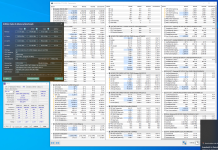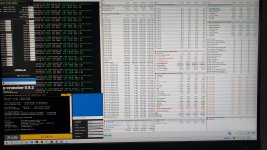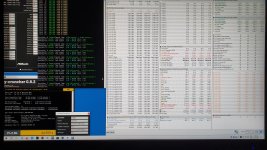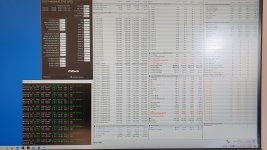Veii
Enthusiast
- Mitglied seit
- 31.05.2018
- Beiträge
- 1.481
- Desktop System
- QA Platform
- Laptop
- ASUS 13" ZenBook OLED [5600U]
- Details zu meinem Desktop
- Prozessor
- Intel Core Ultra 9 285K
- Mainboard
- ASRock OC Formula
- Kühler
- Alphacool T38 280mm
- Speicher
- G.Skill Z5 CK 9600
- Grafikprozessor
- GTX1080ti KP [XOC ROM] // EVGA GTX 650 1GB [UEFI GOP]
- Display
- KOORUI GN10 miniLED
- SSD
- Samsung EVO 850
- Soundkarte
- ESI Ambier i1 & AKG P820
- Gehäuse
- Open-Bench
- Netzteil
- Corsair SF85 // Seasonic GX-550
- Keyboard
- Topre Realforce 108UBK 30g [Silenced]
- Mouse
- Endgame-Gear OP1 8K
- Betriebssystem
- Win11
- Internet
- ▼42 MBit ▲15 MBit
Mmmmmir ist bewusst das es einige boards gibt die 8000mhz schaffen , aber wenn man mehr als nur das möchte dann wirds schon enger.
vorallem muss man auch vergleichen was boards sonst so können (wieviele usb slots,m2, und und und)
Es ist schwer für mich hier mitzureden, da ich auch dem APEX Bios nicht vertraue.
Man muss selber Hand anlegen, damit Sachen laufen. Es ist traurig, aber so war meine gesamte Intel Erfahrung bis jetzt.
Von der Sicht eines Normalnutzers, ja ich kann es verstehen.
Ich finde es weiterhin peinlich dass Intels V/F Curve Points, bzw man beginnt schon bei CEP auf B760 ~ fast allen Boards fehlt, obwohl es Intel features sind.
Dass die Slopes Auswahl fast überall fehlt, oder eine Auslese der aktuellen antrainierten ODT/RTTs.
Es ist sehr peinlich.
Das ganze läuft solider bei AMDs ecosystem, für die Kunden.
Einfach da sich fast alle Mainboards nahezu identisch benehmen, da AMD ein gewissen Zwang und Druck ausübt.
// EDIT: Fast alle 6 Layer 2DPC cappen auf 7600MT/s.
// Die Oberklasse auf 7800MT/s. Und die 1 DPC zwischen 7800-8800MT/s. Straps zwischen 8200-8667 sind kapput.
// Sie benehmen sich alle nahezu Identisch da nicht nur die PCB design-targets erzwungen werden, sondern auch das Bios bzw die Biospredictions.
Das Naheliegendste an einem Apex/Extreme (bzw [Dark]Hero) ~ wäre womöglich das Tachyon X & als 2DPC dann das Aorus Pro X.
ASRock hat die Chance, aber die beiden Boards fehlen einfach im westlichen Markt. Das Tachi ist ok, alles eine einstell-Sache.
EVGA hatte die Chance, aber ja ~ was soll man machen.
MSI bietet soweit garnichts, nur das Z690 UnifyX.
Man kann es ASUS nicht übel nehmen.
Sie sind riesengroß. Mit sehr vielen angestellten Talenten.
Beitrag automatisch zusammengeführt:
I want the oppositeIt trains 82 now, it was 84 before.
I reseated the CPU 3 times, getting the same MC SP.
One reseat (you already have), 5 tests.
Variance is not a Thermal topic.
@zebra_hun @tibcsi0407 progress on scewin ?
@zebra_hun progress on Groups_ODT + 8200 ?
Zuletzt bearbeitet:







